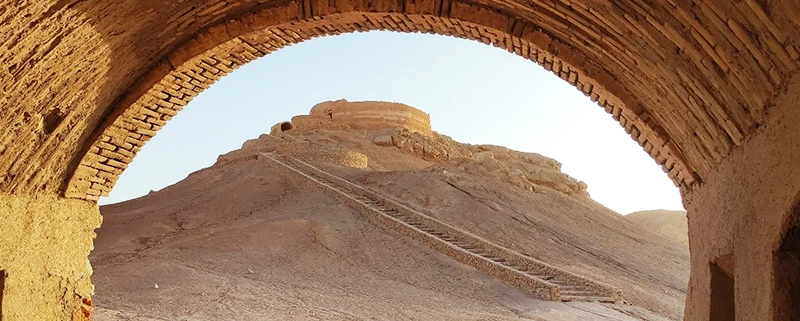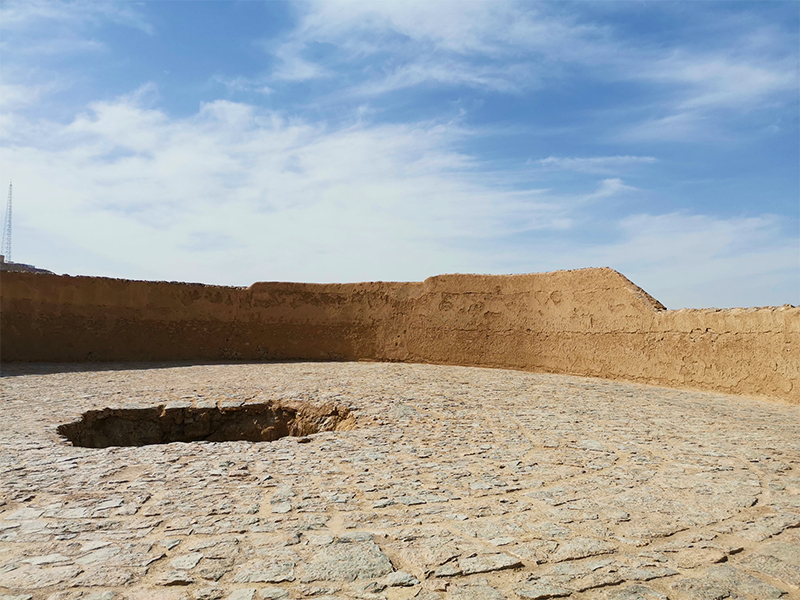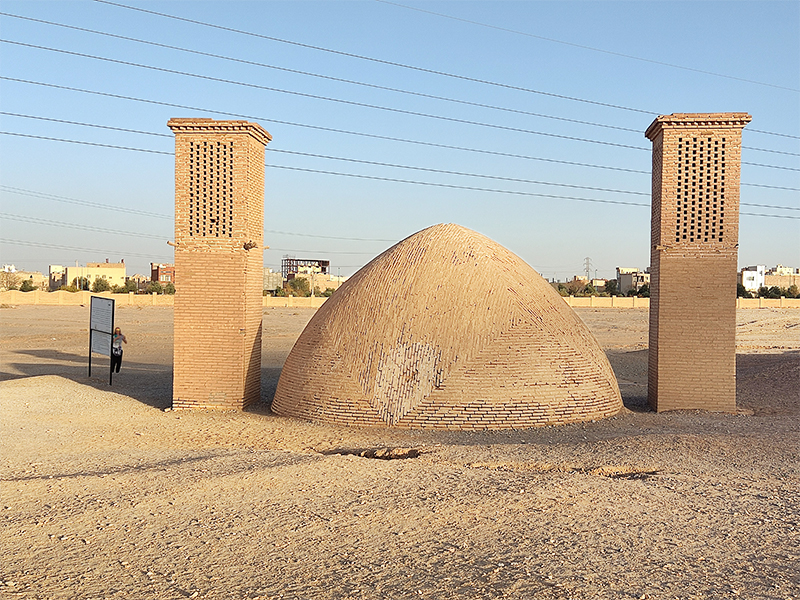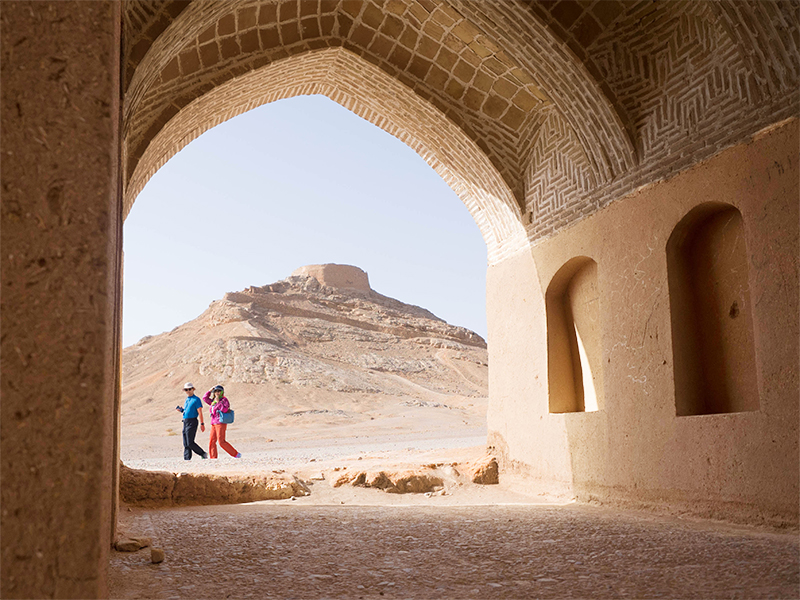Yazd Tower of Silence (Photos, History, Facts, timing)
Within the arid landscapes of Yazd, Iran, stands a testament to ancient beliefs and cultural practices, which is called the Tower of Silence. Also known as Dakhma or Dokhma, this enigmatic structure is a revered site for followers of the Zoroastrian faith, offering a glimpse into a unique funerary tradition that dates back centuries. Yazd Tower of Silence, with its intricate history and cultural significance, serves as a bridge connecting the past to the present, allowing us to explore the rich tapestry of religious practices that have shaped the region’s identity.
Yazd Tower of Silence History
The Zoroastrian religion, founded by the prophet Zoroaster (Zarathustra) around 1500 BCE in ancient Persia (modern-day Iran), introduced concepts that influenced later monotheistic religions. Central to Zoroastrian beliefs is the idea of a cosmic struggle between the forces of good and evil. Death and the afterlife hold deep significance, and the Zoroastrian funerary rituals reflect this spiritual perspective.
The Tower of Silence, built upon circular and raised platforms, was designed to fulfill a specific purpose in the Zoroastrian afterlife tradition. The Zoroastrians believed in maintaining the purity of the elements, and the dead body was considered impure due to its contact with death. To prevent contaminating the earth, water, and fire – all considered sacred in Zoroastrianism – the Tower of Silence was created as an alternative to traditional burial or cremation.
Cultural Significance
The Tower of Silence holds profound cultural significance within the Zoroastrian community. It represents an enduring link to the past, carrying forward ancient traditions that have been preserved across generations. Despite the gradual decline in the Zoroastrian population in Iran and the modernization of funeral practices, the Tower of Silence stands as a testament to the unwavering devotion of the Zoroastrian community to its beliefs.
In recent years, however, changes in environmental regulations and urbanization have posed challenges to the traditional practice of the Tower of Silence. Concerns about vulture populations, health considerations, and changing social norms have led to debates within the Zoroastrian community about the future of this practice.
The Ancient Zoroastrian Towers of Silence Functionality
The construction of Dakhmas, also known as Towers of Silence, and the practice of placing the deceased within them were deeply rooted in the belief system of the Zoroastrians. Zoroastrians perceived the world as composed of four essential elements: water, fire, earth, and air. Due to this belief, the act of cremation and burial was seen as polluting the purity of these elements. In response, the Zoroastrians devised an ingenious solution to prevent the contamination of the elements by constructing towers with elevated platforms.
Following an individual’s passing, the Zoroastrians would carry the body to a Tower of Silence or Dakhma. This practice allowed the body to be returned to nature without compromising the purity of the natural elements. These towers were meticulously designed in accordance with fascinating principles.
Separate areas within the Dakhma were designated for the bodies of men, women, and children. The central space of the circular tower, known as the “estudan,” was dedicated to the burial and disinfection of bones. The bodies of the deceased served as sustenance for scavenger birds such as crows and other avian creatures.
Once the scavenging process was complete, the remaining bones were carefully placed within the “estudan,” a central well-like structure within the Dakhma. This intricate process was meticulously orchestrated to ensure that neither the earth nor fire would be contaminated. Within the empty central space of the Dakhma, the “estudan” well served as the repository for the bones left behind after the scavenging process. This process embodied the Zoroastrian understanding of life and death as part of a greater cosmic cycle, reinforcing their deep connection to the elements and nature itself.
Yazd Tower of Silence Facts
One of the most interesting facts about the Tower of Silence is the Zoroastrian ecological solution for funerals. The tower’s elevation and circular design were ingeniously conceived to address the Zoroastrian belief in preserving the purity of the elements. By exposing the deceased to scavenger birds, such as vultures, the natural decomposition process occurred without contaminating the sacred earth, fire, water, and air.
One of the intriguing aspects of the Tower of Silence is its segmented layout, with distinct sections allocated for men, women, and children. This meticulous division reflects the Zoroastrian commitment to maintaining order and reverence, even in the afterlife. The attention to such details highlights the deep cultural significance attached to these rituals, emphasizing the importance of respecting every individual’s journey beyond life.
At the heart of the Tower of Silence lies the “estudan” well, a central feature with profound symbolism. This well served as a repository for the bones that remained after the scavenger birds had completed their work. This thoughtful design not only emphasized the Tower’s role in natural decomposition but also allowed the Zoroastrian community to honor their loved ones by ensuring a dignified resting place for their remains. The “estudan” represents a bridge between the physical and spiritual realms, embodying the Zoroastrian belief in the cyclical nature of life and death.
Is Tower of Silence Still Used?
Until the year 1971, funerary rituals involving the Tower of Silence, such as placing the deceased within the tower for exposure, were conducted at this site. However, after that point, these ceremonies were discontinued.
It appears that the practice of utilizing the Tower of Silence for funerary purposes ceased in the past. Environmental changes, health concerns, shifts in cultural behaviors, and the inclination to align with modern norms have contributed to alterations in burial methods and related rituals within the Zoroastrian community.
Furthermore, the proximity of the Zoroastrian cemetery to this location suggests that after discontinuing the Tower of Silence rituals, the community transitioned to different burial methods, including in-ground burials, near the Tower of Silence. These changes could symbolize the evolution of the Zoroastrian society’s culture and civilization in response to contemporary challenges.
Dakhma
Dakhmas are structures constructed from raw clay that have held significant importance throughout ancient times. They were utilized as locations for religious and spiritual ceremonies following a person’s passing. For instance, Zoroastrians adhered to the tradition of placing their deceased within these Dakhmas after performing specific rituals with defined customs, a practice that continued until just a few decades ago.
Dakhmas were either naturally formed or constructed by human hands, all featuring an elevated position to allow scavenger birds such as vultures, particularly crows, easy access to the bodies. Subsequently, the remains of these individuals would be placed within a well inside the Dakhma to prevent contamination from the earth.
Dakhma Design
These circular spaces were often constructed atop high mountains, away from villages and settlements, providing distance from the local population. The walls surrounding the Dakhma were built from stone and cement, and a small iron door was designed for entry and exit. The area within the Dakhma was approximately one hundred meters in circumference.
You can easily understand the greatness of these historical Dakhmas by viewing the Yazd Tower of Silence photos. The interior floor sloped downward from the walls towards the center, where a deep well was situated, sometimes accompanied by four deeper wells around the dakhma’s periphery. The depths of these wells were typically filled with sand and gravel, reaching about one meter deep.
Dakhma in Culture
Dakhmas, or Towers of Silence, have been an integral part of the Zoroastrian funerary tradition for ages, embodying a unique approach to death and the afterlife. Their circular design and elevated location not only facilitated the decomposition of bodies but also connected the deceased to the sacred elements and the cosmos, aligning with Zoroastrian spiritual beliefs.
While the traditional use of Dakhmas has waned in recent decades due to environmental concerns, changing societal norms, and other factors, these structures stand as profound relics of ancient customs and spiritual practices. The Dakhmas continue to intrigue scholars, historians, and individuals interested in exploring the intricate relationship between culture, architecture, and religious beliefs. As we contemplate the past and the present, these Towers of Silence remind us of the diverse ways in which humanity has sought to navigate the mysteries of life, death, and the spiritual realm.
More Information to Visit Yazd Tower of Silence
Yazd Tower of Silence address: Yazd, Safaiyeh, end of Shahidan Ashraf Blvd., Dakhmeh Mountain (Location on map)
Yazd Tower of Silence visiting hours: Every day from 7:00 AM to 5:30 PM.
Yazd Tower of Silence entry fee: About 2 USD.
Recommended duration of visit: 1 to 2 hours
Final Word
The Yazd Tower of Silence stands as a symbol of the enduring legacy of Zoroastrianism and its unique approach to death and the afterlife. It is a testament to the intricate relationship between culture, religion, and architecture. The Tower of Silence not only encapsulates ancient beliefs but also challenges us to contemplate the complexities of tradition in a rapidly changing world. As modern society and ancient customs intersect, it is crucial to approach these intersections with respect for heritage and a willingness to engage in thoughtful dialogue about the preservation of cultural practices.
Are you planning to travel to Iran and looking for an Iran travel agency? Check out our Iran tours and feel free to contact us. Maybe you will find more interesting things to do in Yazd.










Leave a Reply
Want to join the discussion?Feel free to contribute!